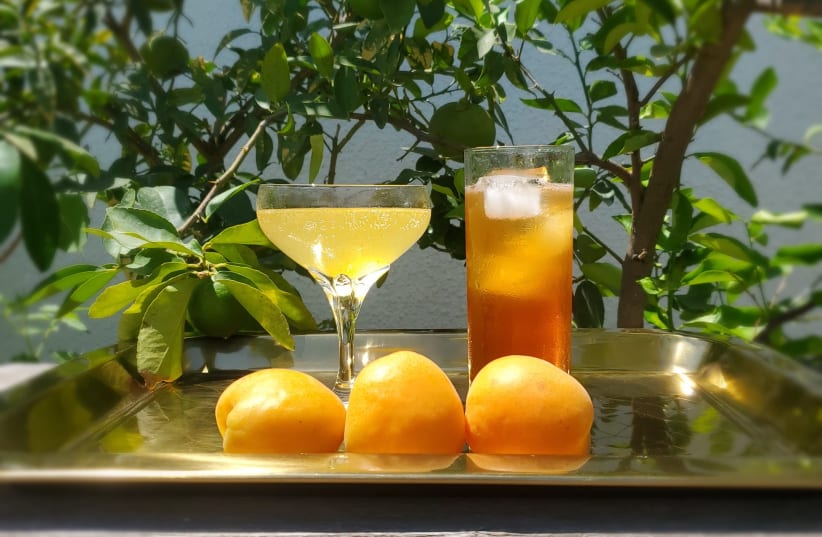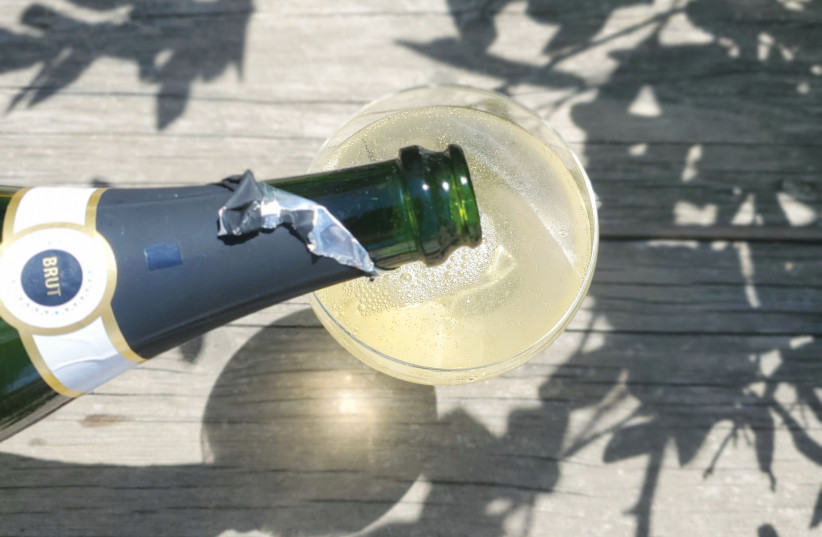Despite being hot outside, drinking alcohol in the Middle East is a challenge. Between religious and social restrictions, and fees in shipping and production, it’s often a prohibitively expensive (if not prohibited outright) activity.
Until recently, ordering a mixed drink at any bar in Israel meant getting a double shot of liquor, a bottle of mixer, a highball glass with a few ice cubes, and a hefty bill at the end.
And many of us have been guests at Shabbat dinner, where the overly chilled red Kiddush wine magically appears and then disappears back into the refrigerator for another week.
And yet in this region, where beer, wine, and distilled spirits were first produced, innovation in the drinks menu continues to be made. The ingenuity that was responsible for creating a bevy of non-alcoholic beverages, in keeping with Islam’s prohibition on alcohol, has helped make flavored syrups a worldwide industry. The ancient vineyards and fields of grain are once again being turned into liquids. And the cocktail craze that has swept through most global cities is making its presence felt, both in our region and Diaspora communities worldwide.
Few have been able to tell the Middle East’s story in its entirety; whether it’s excluding an entire nation and/or people from narratives or forgetting about communities of inhabitants beyond the region’s artificial borders, there’s so much yet to be said and so many similarities yet to be noticed.
With all the attempts and failures to find understanding and stability in the Middle East, why not try to reach people through their cups and glasses?
In this weekly column, I plan to reintroduce our region’s array of flavors to your liquor cabinets and stemware. Together, we’ll explore how others, both in the region and around the world, are connecting with the Middle East behind the bar. And we’ll find ways to match the region’s reality with our own aspirations, producing a drinking culture that’s affordable, respectful and, above all, thirst-quenching.
I started Sheik It Up as a continuation of my fascination – which began when I was little – with maps, the Middle East, languages, and eating at restaurants featuring cuisines from around the world. I credit my parents for this early interest, who fostered my love of travel, different foods, restaurants, and cocktails from an early age. They took me to my first Thai restaurant in Washington, DC, just blocks from our apartment, where I was introduced to chopsticks and Shirley Temple (the cocktail).
On Instagram, I post a drink every Friday afternoon from wherever I am – be it at home, on vacation, or visiting family in the US – with some quasi-inspirational message and a wish for a Shabbat shalom and a good weekend. I set out the ingredients in the drink, and hashtag the star ingredient in our region’s four major languages: Hebrew, Arabic, Persian, and Turkish.
From there, the drinks became a short-lived blog: a series of tastings for friends and complete strangers looking to try something different; inspiration for local brands to develop their own cocktails; and a lot more besides.
I want to thank The Jerusalem Post for this opportunity for many more of us to drink together, online (and maybe offline in the future). Together, we’ll rediscover and reconnect to our region, our identities, and each other – one drink at a time.
Love in the grape season
Tu B’Av, which we celebrated this week, may be called the Jewish Valentine’s Day, but our tradition in Mishna Ta’anit 4:8 calls it one of our most joyous days of the year, when the daughters of Jerusalem would wear white and dance in the vineyards – as much to find eligible suitors as to harvest the grapes during the harvest season!
This season, called bah-tzeer in Hebrew, nowadays brings families and friends to vineyards across the country to help with the harvest. People come to cut bunches of grapes from the vines and even help with the initial stages of wine production (no reference to I Love Lucy here – it’s all done with presses or hand-held mashers).
But wine isn’t the only alcoholic drink made from our region’s grapes. Arak is traditionally made from grapes, distilled after fermentation with the addition of anise seeds for its signature flavor and composition (the essential oils in anise are partially soluble in water, creating its signature milky color when mixed with water and ice). In Israel, you can still find arak made in this traditional way, as well as from other fruits such as dates.
This week’s column includes two recipes. One is made with sparkling wine to celebrate the harvest season. The other is a non-alcoholic beverage. Each refreshing drink complements the other.
Tomorrow in the apricot season, today
Grapes are not the only fruit in the Middle East celebrated at this time of year. Although not native to the Middle East, apricots have been cultivated in the region for thousands of years. Its scientific name, Prunus armeniaca, comes from the long-held belief that the fruit’s origin is in Armenia, where it’s lauded as the national fruit.
Apricots appear in nearly every kitchen in the region, wherever that may be. They can be found in braised meat stews and snack bowls, and they are often rehydrated with water to create refreshing drinks and desserts.
What defines the fruit, beyond its sunshine color and taste, ranging from sweet to tart, is how fleeting the fresh fruit’s appearance is in markets. Their availability is so brief, that the classic Arabic expression Bukra fiil-mishmish (“Tomorrow in the apricot season”) is often used to refer to something that is unlikely to happen.
Marrying that connection between the fleeting and the forever is reflected in this week’s drink recipes, showcasing the apricot’s strengths and our region’s current produce season.
Fresh and non-alcoholic: the Bustani
The tannins in the black tea are balanced by the syrup, creating a “tall drink” meant to be sipped at your leisure, with enough ingredients left over for refills. For those interested in an alcoholic version, a splash of bourbon or rum would be ideal.
Ingredients:
- 1 liter home-brewed iced black tea (English Breakfast or Earl Grey)
- 1 cup apricot syrup
- Ginger ale and/or freshly squeezed lemon juice
Optional:
- A few drops of rosewater or orange blossom water
- Ice
- Collins glass or any tall glass for highball drinks
Iced tea:
Use 4-5 tea bags per liter of water. Tie the tea bags together, remove any paper labels, and add to a pitcher of water to sit in the refrigerator overnight or at least 10 hours. Remove the teabags and squeeze them out into the pitcher before discarding them.
Apricot Syrup:
- 1 cup sugar, white or demerara
- 1 cup water
- 2 large or 3 small-medium apricots, preferably not fully ripe
Optional herbs (choose one):
Several sprigs of fresh thyme; two sprigs of fresh sage; one sprig of fresh rosemary; or a handful of dried lavender (available at health stores)
Wash apricots. Slice each of them along their “seam,” separating them into halves. Discard the pits.
Add sugar, water, apricot halves, and optional herbs to a small saucepan. Heat on medium-high until the sugar is dissolved and the liquid comes to a steady bubble for five minutes. Turn off the heat, and let sit uncovered until it reaches room temperature. Strain the resulting liquid into a glass bottle or jar with lid, and refrigerate until completely cooled. Syrup will thicken as it cools.
Save the now-poached apricot halves to serve with yogurt or ice cream.
To make your own dried apricots:
Discard the herbs and spread out apricot halves on a baking sheet lined with parchment paper (known in Israel as baking paper). Bake at 100 C, on convection mode if possible, until the halves are tacky to the touch. Eat them as a snack.
To serve the Bustani:
Fill a highball or any tall glass halfway with iced tea and 1.5 tablespoons apricot syrup (and optional rosewater or orange blossom water). Stir to combine. Add ice. Top with ginger ale and/or lemon juice, stir to combine. Add more syrup according to taste.
Any remaining syrup would go great mixed with soda water, drizzled on ice cream (see a trend here?), and many more besides. Use your imagination and taste buds to explore!
Preserved and potent: The Forach
A riff on the classic cocktail French 75, so called for its kick akin to a French 75mm. field gun.
Bubbles in any cocktail will amplify the alcohol’s effect, making this drink quite potent. The tartness of the jam helps make it more savory and enables you to pace yourself until the inevitable next round.
Ingredients:
- 30ml. or 2 Tbsp apricot jam (use a brand with 100% fruit and no added sugar), or 1.5 tablespoons of apricot syrup (see previous drink for the recipe)
- 30 ml. or 2 Tbsp gin (I’m a big fan of local Golani Distillery and their Holy Land or Forbidden Etrog gins)
- 15 ml. or 1 Tbsp fresh lemon juice
- Brut sparkling wine (Cava or Prosecco will suffice, as long as it’s dry)
- Ice
- Cocktail shaker (optional, any jar with a screw top lid)
- Champagne flute or coupe
To serve:
Combine jam, gin, lemon juice, and ice in a shaker or jar. Shake well. Strain into a flute or coupe. Top with sparkling wine. Stir gently to combine.
Bonus beverage:
I rediscovered how useful apricot jam in cocktails is when cooking for my extended family. I crafted a recipe for boneless chicken thighs that included dried apricots soaked in vermouth (aromatized wine), garlic, and spices. This has become an instant hit, with the Pyrex baking tray in which it’s made completely emptied, along with the jam jar. Add some gin, shake well until all the last bits are dissolved, top with tonic water and ice, and you’ve earned a well-deserved chef’s treat. ■
Originally from Washington, DC, and now residing in Tel Aviv, the writer is a self-taught mixologist and founder of Sheik It Up, an ‘edutainment’ initiative to promote a better understanding of Israel and the Middle East. He is also the founder of Ḥayyati, a cross-cultural communications consultancy for small businesses, and civic initiative The Here & There Club. jay@hayyati.com


